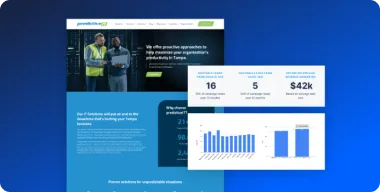Every business wants to grow, but more than most, manufacturing companies face fierce competition and smaller margins. To achieve dynamic, sustainable growth in the digital age you must understand the power of extracting deep insights from your data. But don’t forget, not all data is profitable data.
You may remember a recent article we published on vanity metrics and why you should ignore them in favor of more revealing and actionable data. The five vanity metrics we suggested avoiding were:
- Number of social media followers
- Page views on your website
- Number of website visitors
- Time on site
- Pages per visit
The reason is pretty much the same for all of them: They’re just one piece of a puzzle and don’t give you a full picture of how successful your online marketing efforts are.
Success in manufacturing is about taking advantage of small edges over the competition and capitalizing on the cost efficiencies of digital channels. In this guide, we‘ll talk about the metrics that reveal valuable insights into your market, along with tips on how to ensure your data-driven decisions are helping your business grow.
1. Social media engagement
Social media can be a great source of leads. It can also help you gauge interest in new products or concepts, as well as get feedback on existing ones.
As we wrote about in our vanity metrics post, the total number of your social media followers reveals nothing about the way those followers are engaging with your brand. However, if you can measure how they interact with your shop — that’s more significant. Gaining insights into the engagement of your following is a real advantage, especially when filtered by campaign, product or concept.
For example, imagine you are at the concept stage of a new product for the consumer market. Your market research found that there is a huge potential market, but you are torn between two main product features. The development team tells you it’s impossible or too costly to include both. Research polls and focus groups are split more or less 50/50.
Situations like those are perfect for harnessing the power of social media. You can post promotional articles or videos on Facebook or LinkedIn to generate interest in the new product, but list the two features separately as two distinct products. From there it’s as simple as tracking the number of likes and shares for each. Although not the be-all and end-all, these measurable metrics show you which has more potential in certain markets and creates buzz around your product.
This is great for B2B and B2C markets, as social media is swiftly becoming one of the most effective ways to communicate news and developments to interested parties — more so than more traditional methods such as trade publications or newsletters.
2. Conversion rates/Revenue generated
For B2C manufacturers that have an eCommerce store or that sell through direct response landing pages, conversion rates are obviously far more important than the number of people seeing those pages. It’s crucial that you optimize your content for the former rather than the latter to avoid problems with your marketing strategies.
If conversions are falling off, you may need to improve the layout of your landing page or strengthen your calls-to-action, for instance. With a big enough sample size, you can create two versions of a landing page and compare conversion rates to better understand what’s working and what isn’t.
For B2B manufacturers, the conversions measured could be leads rather than direct sales. To improve the chances of increasing your lead generation, you need to offer high-quality, compelling content, persuasive (but not too pushy) copywriting, and easy-to-understand communication channels.
Let’s say you’re tracking sign-ups to an email list. You discover that people are spending time on your site, but not converting to a sign up. In this case it’s a good idea to create a “lead magnet,” such as a short, informative e-book or video series related to your industry. You can then use your conversion metric to see whether this moves the needle in the right direction.
3. Page visits for new and returning visitors
Rather than analyzing overall site traffic, try measuring “page visits for new and returning visitors” to get a clearer picture of engagement that people are finding most valuable on your site.
For instance, if you find that new visitors are looking at an average of six pages, but returning visitors look at only one or two, then it could be that your content needs to be updated more regularly. Or, it may be that you need to incentivize new visitors to return to your site. For instance, you could email them links to your great, new curiosity-arousing content or even a promotion, such as free tickets to a trade event.
Action leads to active growth
Interpreting the metrics mentioned above and keeping a close eye on trends and correlations will reveal insights into the effectiveness of your online marketing. The next step is to act upon that information. This may involve testing changes you make and getting granular detail on advertising campaigns, for instance. It’s an ongoing process that gets results if carried out properly, so make sure you are choosing the right data to track and analyze.
For years we’ve been building websites and optimizing marketing campaigns for industrial businesses all over the world. From Google AdWords management to custom-designed PDF brochures, we can transform your online presence. Send us a message today to learn more!
“






